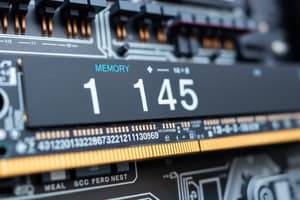Podcast
Questions and Answers
ما هو الهدف من تكنولوجيا الذاكرة؟
ما هو الهدف من تكنولوجيا الذاكرة؟
- إنقاص الأبعاد (الحجم) والتكلفة واستهلاك الطاقة
- كل ما سبق (correct)
- زيادة السعة والسرعة
- لا شيء مما سبق
ما هي تقنية RAM قبل عام 1975؟
ما هي تقنية RAM قبل عام 1975؟
النواة المغناطيسية
تستبدل تكنولوجيا الترانزستور تقنية النواة المغناطيسية في RAM.
تستبدل تكنولوجيا الترانزستور تقنية النواة المغناطيسية في RAM.
True (A)
ما هي أنواع ذاكرة أشباه الموصلات؟
ما هي أنواع ذاكرة أشباه الموصلات؟
ما هي المواد شبه الموصلة؟
ما هي المواد شبه الموصلة؟
ما هي المرحلة الأولى من عملية تصنيع الرقاقة؟
ما هي المرحلة الأولى من عملية تصنيع الرقاقة؟
قم بمطابقة كل من أنواع الذاكرة أدناه مع وظيفتها
قم بمطابقة كل من أنواع الذاكرة أدناه مع وظيفتها
تعتبر ذاكرة القراءة فقط (ROM) من أنواع الذاكرة الدائمة.
تعتبر ذاكرة القراءة فقط (ROM) من أنواع الذاكرة الدائمة.
ما هي أنواع الذاكرة RAM؟
ما هي أنواع الذاكرة RAM؟
تُستخدم ذاكرة RAM لتخزين التعليمات والبرامج والبيانات.
تُستخدم ذاكرة RAM لتخزين التعليمات والبرامج والبيانات.
ما هي طرق الوصول إلى الذاكرة؟
ما هي طرق الوصول إلى الذاكرة؟
ما هي مزايا ذاكرة SRAM؟
ما هي مزايا ذاكرة SRAM؟
تتميز ذاكرة الوصول العشوائي المتزامنة (SDRAM) بسرعة عالية من خلال التزامن مع معالج CPU.
تتميز ذاكرة الوصول العشوائي المتزامنة (SDRAM) بسرعة عالية من خلال التزامن مع معالج CPU.
ما هي DDR SDRAM؟
ما هي DDR SDRAM؟
يتم تخزين نظام الإدخال/ الإخراج الأساسي (BIOS) في ROM.
يتم تخزين نظام الإدخال/ الإخراج الأساسي (BIOS) في ROM.
ماذا تعني UEFI؟
ماذا تعني UEFI؟
تعتمد ROM على قاعدة الديودات للتخزين.
تعتمد ROM على قاعدة الديودات للتخزين.
يمكن مسح EPROM باستخدام الأشعة فوق البنفسجية.
يمكن مسح EPROM باستخدام الأشعة فوق البنفسجية.
يمكن مسح EEPROM باستخدام عملية كهربائية.
يمكن مسح EEPROM باستخدام عملية كهربائية.
ما هي مجالات استخدام ذاكرة الفلاش؟
ما هي مجالات استخدام ذاكرة الفلاش؟
لا يمكن إعادة البرمجة ل ذاكرة الفلاش أكثر من 100,000 مرة.
لا يمكن إعادة البرمجة ل ذاكرة الفلاش أكثر من 100,000 مرة.
ما هي MM؟
ما هي MM؟
تُستخدم MM في حفظ البيانات و التعليمات التي تتطلب الوصول السريع أثناء عمل CPU.
تُستخدم MM في حفظ البيانات و التعليمات التي تتطلب الوصول السريع أثناء عمل CPU.
يمكن زيادة سعة MM بزيادة عدد الخطوط أو حجم الخطوط.
يمكن زيادة سعة MM بزيادة عدد الخطوط أو حجم الخطوط.
يستخدم MAR في الوصول إلى MM بنظام الترميز الثنائي.
يستخدم MAR في الوصول إلى MM بنظام الترميز الثنائي.
يُمكن توصيل ذواكر أصغر مع بعضها لزيادة سعة MM بشكل متسلسل فقط.
يُمكن توصيل ذواكر أصغر مع بعضها لزيادة سعة MM بشكل متسلسل فقط.
Flashcards
أهداف تطوير تكنولوجيا الذاكرة
أهداف تطوير تكنولوجيا الذاكرة
تطور تكنولوجيا الذاكرة عبر عقود لتقليص أبعادها (الحجم) وتكلفة تصنيعها واستهلاكها للطاقة، وزيادة سعتها وسرعتها.
ذاكرة النوى المغناطيسية
ذاكرة النوى المغناطيسية
كانت تكنولوجيا الذاكرة تعتمد على النوى المغناطيسية في الفترة من 1955 إلى 1975 والتي تتكون من حلقات صغيرة مصنوعة من الفريت (سيراميك مغناطيسي) مع أسلاك القراءة/الكتابة التي تمر من خلالها.
تقنية MOS و CMOS
تقنية MOS و CMOS
تقنية MOS و CMOS هي تقنيات تصنيع مكونات إلكترونية (بوابات منطقية ، دوائر منطقية ، إلخ) تعتمد على أشباه الموصلات.
أشباه الموصلات
أشباه الموصلات
Signup and view all the flashcards
السليكون (سي )
السليكون (سي )
Signup and view all the flashcards
الوافر (لوح السيليكون)
الوافر (لوح السيليكون)
Signup and view all the flashcards
عملية تصنيع أشباه الموصلات
عملية تصنيع أشباه الموصلات
Signup and view all the flashcards
الدوائر المتكاملة (الرقائق الإلكترونية)
الدوائر المتكاملة (الرقائق الإلكترونية)
Signup and view all the flashcards
الذاكرة
الذاكرة
Signup and view all the flashcards
الكتابة إلى الذاكرة
الكتابة إلى الذاكرة
Signup and view all the flashcards
قراءة من الذاكرة
قراءة من الذاكرة
Signup and view all the flashcards
أنواع الذاكرة
أنواع الذاكرة
Signup and view all the flashcards
هرم الذاكرة
هرم الذاكرة
Signup and view all the flashcards
ذاكرة الكتلة
ذاكرة الكتلة
Signup and view all the flashcards
ذاكرة الكاش
ذاكرة الكاش
Signup and view all the flashcards
ذاكرة أشباه الموصلات
ذاكرة أشباه الموصلات
Signup and view all the flashcards
ROM
ROM
Signup and view all the flashcards
RAM
RAM
Signup and view all the flashcards
ذاكرة الكاش
ذاكرة الكاش
Signup and view all the flashcards
سجلات المعالج
سجلات المعالج
Signup and view all the flashcards
سعة الذاكرة
سعة الذاكرة
Signup and view all the flashcards
وقت الوصول
وقت الوصول
Signup and view all the flashcards
فترة الدورة
فترة الدورة
Signup and view all the flashcards
معدل النقل
معدل النقل
Signup and view all the flashcards
مدة التخزين
مدة التخزين
Signup and view all the flashcards
موقع الذاكرة
موقع الذاكرة
Signup and view all the flashcards
الوصول المتتالي
الوصول المتتالي
Signup and view all the flashcards
الوصول العشوائي
الوصول العشوائي
Signup and view all the flashcards
الوصول شبه المتتالي
الوصول شبه المتتالي
Signup and view all the flashcards
الوصول الترابطي
الوصول الترابطي
Signup and view all the flashcards
RAM
RAM
Signup and view all the flashcards
استخدام RAM
استخدام RAM
Signup and view all the flashcards
أوامر R/W
أوامر R/W
Signup and view all the flashcards
أوامر CS
أوامر CS
Signup and view all the flashcards
خطوط الإدخال
خطوط الإدخال
Signup and view all the flashcards
خطوط الإخراج
خطوط الإخراج
Signup and view all the flashcards
خطوط العنوان
خطوط العنوان
Signup and view all the flashcards
دائرة فك الترميز
دائرة فك الترميز
Signup and view all the flashcards
سعة الذاكرة
سعة الذاكرة
Signup and view all the flashcards
الخلية الثنائية (BC)
الخلية الثنائية (BC)
Signup and view all the flashcards
جدول حالات التشغيل - Flip-Flop
جدول حالات التشغيل - Flip-Flop
Signup and view all the flashcards
جدول Karnaugh
جدول Karnaugh
Signup and view all the flashcards
دوائر منطقية متكاملة
دوائر منطقية متكاملة
Signup and view all the flashcards
عدد مخرجات دائرة فك الترميز
عدد مخرجات دائرة فك الترميز
Signup and view all the flashcards
اختلاف SRAM و DRAM في طريقة التخزين
اختلاف SRAM و DRAM في طريقة التخزين
Signup and view all the flashcards
اختلاف SRAM و DRAM في مدة التخزين
اختلاف SRAM و DRAM في مدة التخزين
Signup and view all the flashcards
اختلاف SRAM و DRAM في البنية
اختلاف SRAM و DRAM في البنية
Signup and view all the flashcards
اختلاف SRAM و DRAM في سرعة الوصول و التكلفة
اختلاف SRAM و DRAM في سرعة الوصول و التكلفة
Signup and view all the flashcards
SDRAM
SDRAM
Signup and view all the flashcards
DDR - SDRAM
DDR - SDRAM
Signup and view all the flashcards
مميزات DDR-SDRAM
مميزات DDR-SDRAM
Signup and view all the flashcards
استخدام DDR-SDRAM
استخدام DDR-SDRAM
Signup and view all the flashcards
ذاكرة ECC
ذاكرة ECC
Signup and view all the flashcards
ROM
ROM
Signup and view all the flashcards
BIOS
BIOS
Signup and view all the flashcards
UEFI
UEFI
Signup and view all the flashcards
ROM الكلاسيكي
ROM الكلاسيكي
Signup and view all the flashcards
PROM
PROM
Signup and view all the flashcards
EPROM
EPROM
Signup and view all the flashcards
EEPROM
EEPROM
Signup and view all the flashcards
ذاكرة فلاش
ذاكرة فلاش
Signup and view all the flashcards
استخدام ROM
استخدام ROM
Signup and view all the flashcards
Study Notes
Chapter 2: Memories - Part one
- This chapter covers memory technologies.
- The goal of memory technology is to reduce dimensions (size), costs, and energy consumption while increasing capacity and speed.
- From 1955 to 1975, RAM technology was based on magnetic cores (small ferrite rings).
- Semiconductor technology (MOS and CMOS) has greatly advanced since then.
- Transistors, particularly MOS-FETs, are crucial components in modern electronics (logic gates).
- Memory is an electronic device capable of storing and retrieving binary information.
- It involves two basic operations: writing to store information and reading to restore it.
Memory Hierarchy
- The ideal memory would have unlimited capacity and speed, but unfortunately, faster memories often have lower capacity and are more expensive.
- A memory hierarchy is used to solve this, organizing memories with varying speeds and capacities, placing the most frequently used data in faster (and more costly) memory.
- The hierarchy includes registers, cache memory, main memory, backup memory, and mass memory.
Semiconductor Memories
- Semiconductor memories are categorized into two families depending on whether writing is allowed: RAM (Random Access Memory) and ROM (Read Only Memory).
- ROM is a read-only memory which contains the computer's startup program.
- RAM is volatile; the data is lost when the power is off. It is used for working memory (data and instructions).
- Cache memory is a high-speed buffer designed to store copies of frequently accessed data from main memory. It significantly improves data access speed.
Memory Characteristics
- Capacity (Size): The amount of information a memory can store, measured in bits, bytes, kilobytes, megabytes, etc.
- Access Time (At): The time taken for a read/write operation, measured from when the request is made to when the data is available.
- Cycle Time (Ct): The minimum time interval between two successive read or write accesses in random access memory. This includes the access time and any setup necessary between operations.
- Throughput: The rate at which information is read or written to memory. It's measured in bits per cycle.
- Storage Duration: The time information is stored in memory, this can be permanent or temporary (depending on the memory type).
Memory Access Modes
- Sequential Access: Information is accessed in a sequential order, typical of magnetic tapes. Access time varies significantly based on the location of the data.
- Random Access: Direct access to information based on an address; access time is constant. This is the operation of RAM and other storage.
- Semi-Sequential Access: Intermediate approach; combines direct and sequential, like hard drives. Access time isn't constant.
Internal Memory Types
- This section classifies different semiconductor memory types such as ROM, PROM, EPROM, EEPROM, and Flash ROM.
- Different kinds of RAM such as SRAM and DRAM with their subgroups are introduced (Fast Page Mode (FPM), Extended Data Out (EDO), Burst EDO (BEDO), Synchronous DRAM (SDRAM), Double Data Rate SDRAM (DDR-SDRAM)).
Memory Expansion
- Techniques to increase memory size by connecting smaller memory modules in series or parallel, including increasing the number of address lines to access more memory lines.
Application Exercises
- Includes a number of exercises (1, 2, 3, 4, 5, 6, 7, 8, 9, 10)
- Various exercises that show how to design, calculate, or use specific memory technologies (RAM, ROM, PROM, etc.) in different scenarios.
Studying That Suits You
Use AI to generate personalized quizzes and flashcards to suit your learning preferences.




